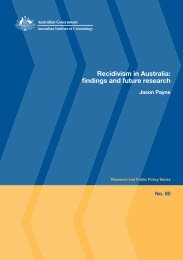Review of anti-corruption strategies Rob McCusker - Australian ...
Review of anti-corruption strategies Rob McCusker - Australian ...
Review of anti-corruption strategies Rob McCusker - Australian ...
Create successful ePaper yourself
Turn your PDF publications into a flip-book with our unique Google optimized e-Paper software.
Michael B 2004. Explaining organizational change in international development: the role <strong>of</strong> complexity in<br />
<strong>anti</strong>-<strong>corruption</strong> work. Journal <strong>of</strong> international development 16(8): 1067–1088<br />
This paper explains the rapid expansion <strong>of</strong> programmes undertaken by donor agencies in the 1990s and<br />
considers four schools <strong>of</strong> <strong>anti</strong>-<strong>corruption</strong> project practice: universalistic, state-centric, society-centric, and<br />
critical schools <strong>of</strong> practice. The paper argues that a complexity perspective <strong>of</strong>fers a new framework for<br />
looking at such growth.<br />
Mocan N 2004. What determines <strong>corruption</strong>? International evidence from micro data. NBER working<br />
paper no. 10460<br />
This paper utilises a micro-level data set from 49 countries to address three issues: What determines<br />
<strong>corruption</strong> at the individual level? What determines the perception <strong>of</strong> the extent <strong>of</strong> <strong>corruption</strong> in the<br />
country? Does <strong>corruption</strong> have a direct impact on growth when the quality <strong>of</strong> the institutions are<br />
controlled for? In addition, the paper creates a direct measure <strong>of</strong> <strong>corruption</strong> which portrays the extent<br />
<strong>of</strong> <strong>corruption</strong> as revealed by individuals who live in those countries. The second part <strong>of</strong> the paper shows<br />
that controlling for endogeneity <strong>of</strong> <strong>corruption</strong> and institutional quality, actual <strong>corruption</strong> in the country and<br />
the proportion <strong>of</strong> the bribes asked by various government agencies have no direct impact on <strong>corruption</strong><br />
perception. On the other hand, an improvement in the quality <strong>of</strong> institutions lowers the perception<br />
<strong>of</strong> <strong>corruption</strong>. The final section <strong>of</strong> the paper shows that controlling for the quality <strong>of</strong> the institutions,<br />
<strong>corruption</strong> does not have a direct impact on growth.<br />
Organisation for Economic Co-operation and Development 2004. <strong>Review</strong> on assessing effectiveness <strong>of</strong><br />
integrity and <strong>anti</strong>-<strong>corruption</strong> measures in the public service: the Korean experience. Public Governance<br />
and Territorial Development Directorate. Public Governance Committee<br />
This paper comprises a case study which compares key components and phases <strong>of</strong> assessment<br />
methodologies implemented by the Korea Independent Commission Against Corruption and the Seoul<br />
Metropolitan Government.<br />
Rock MT & Bonnett H 2004. The comparative politics <strong>of</strong> <strong>corruption</strong>: accounting for the East Asian<br />
paradox in empirical studies <strong>of</strong> <strong>corruption</strong>, growth and investment. World development 32(6): 999–1017.<br />
This paper reports on the notion that <strong>corruption</strong> reduces investment and/or slows growth. The paper<br />
considers the conducting <strong>of</strong> a series <strong>of</strong> cross-country regression tests using four different <strong>corruption</strong><br />
datasets. It notes that <strong>corruption</strong> slows growth and/or reduces investment in most developing countries,<br />
particularly small developing countries, but increases growth in the large East Asian newly industrialising<br />
economies. The latter finding provides solid empirical support to a country case literature that explains<br />
the East Asian paradox––the combination <strong>of</strong> high <strong>corruption</strong> and high growth––in terms <strong>of</strong> stable and<br />
mutually beneficial exchanges <strong>of</strong> government promotional privileges for bribes and kickbacks.<br />
Rose-Ackerman S 2004. The challenge <strong>of</strong> poor governance and <strong>corruption</strong>. Copenhagen Consensus<br />
Challenge papers. http://osp.stanford.edu/files/challenge_poor_gov.pdf<br />
This book notes that the World Bank estimates that $1 trillion is spent on bribes annually, some 3 percent<br />
<strong>of</strong> global GDP but that the impact on economic growth and world income could well be much higher than<br />
this. It suggests that <strong>corruption</strong> is one symptom <strong>of</strong> a failure to achieve an appropriate balance between<br />
private wealth and public power and that global solutions to this challenge are difficult to find because<br />
<strong>corruption</strong> and poor governance have a variety <strong>of</strong> causes. Solutions are not easy to implement because<br />
they disadvantage powerful vested interests that can block reforms. Despite these caveats, carefully<br />
tailored policies – carried out with the personal commitment <strong>of</strong> those on the ground – can have large<br />
benefits and very low costs.















